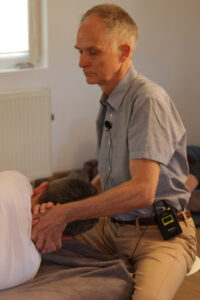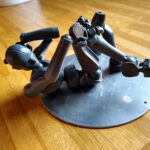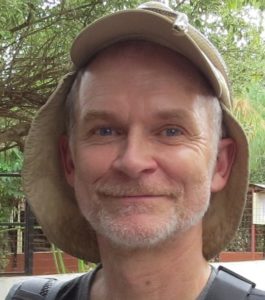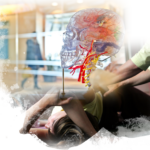
It is a difficult question – What is feldernkrais? (This is my first blog post in English. In the end you will find a audio recording of a Feldenkrais lesson I taught at a workshop in Poland some years ago. Hope you like it.)
Many years ago I heard Mark Reese say that to explain the Feldenkrais Method is as difficult as to explain life itself and after spending the last 35 years of my life trying to understand it I can only agree.
My first contact
When I fists came in contact with the FM in 1984, I had been a physical therapist for two years and in my spare time I was a track and field coach. I thought that I knew a lot about movement and how my body worked. But already after the first ATM – lesson (Awareness through movement) I realized that my knowledge of how I moved and what happened in my body when I moved was very limited. Many years has passed since then and after working with thousands of people I still have a lot to learn.
Limited knowledge
I also realized that I was in no way unique, we have a very limited knowledge about how we act and move, This means that we often get lost and hurt our self.

And for me the Feldenkrais Method is a way of living, and a method to learn how to make life easier and more enjoyable. And it had made a great input on my life both mentally and physically. It gives me a way to cope with all the difficulties that life brings in my way.
Since 1990 I have made my living through teaching the method to other people. I have had the great fortune to teach it to different people from the age of 1 year to 98, to people with different handicap as well as to top athletes. Both individually and in group settings.
In 2006 I became an assistant trainer and have been teaching at Feldenkrais educations and also regularly teach advanced trainings for Feldenkrais practitioners.
About learning

As the method is about learning it works for anyone that has a nervous system no matter age or problem and applied in the right way it is very effective.
Around the world it is used in healthcare, teaching, dans, sports, personal development and in many more domains.
Personally, I have mainly worked with people with different kind of health issues. Like chronic pain, neurological problems (MS, Parkinson, Stroke etc.), sport injuries, stress related problems. I have also worked with a few Swedish top athletes. I regularly teach workshops both in Sweden and abroad.
Fantastic and different
My hope is that FM will grow over the world so that more people will get the benefits of it. It will absolutely make the world a better place.
The method is fantastic but also very different compared to most other things that are available in our modern world. Moshe Feldenkrais way of understanding how our brain works and how we learn was unique at that time, now science are catching up with him. He understood that movement are essential for learning and a way for better health. But it is not any movement! The quality of the movement are of greatest importance. To be able to learn and change things we need to slow down. We need to pay attention and do small and slow movements.
Very simple, but…
To change your possibilities in life is actually very simple! Slow down, do less, pay attention and experiment. We all did this when we where babies and we can do it as adults.
But most of us has learned to act, not according to our needs but according to the needs of the society and other people. We hurry, we strain, we neglect the different signals from our bodies. We listen to other people (parents, teachers, coaches) when they tell us to do more, speed up etc. We forget to listen to the signals from our body when it tells us what is going on.
An example

A couple of days ago I went out for a run. After 2 k I could feel a slight pain in my right calf. Now I had some options.
- I could neglect it and keep on running.
- I could stop running and maybe walk to see if the pain goes away.
This are usually the two things that people use in situations like this, but there is also a third option.
- The Feldenkrais way.
With option 1 the risk that the pain will increase are very big, keep on doing what gives you pain usually gives you more pain. And if you are good at this you get a problem that can last forever.
Option 2 might take away the pain, but if you want to run it is not the best option and if you start running again there is a risk that the pain comes back.
The Feldenkrais way
Which meant that I slowed down and started to pay attention to my actions and asked some questions.

Where is the pain? It was on the outside of the calf.
Why only on one side? Do I use my two sides differently? And paying attention I noticed that I landed differently on my two feet. I was swinging my two arms differently and some other things.
Then I started playing with the way I was running, I even walked for a while and found that I did something similar in walking. I imitated what I did on the painful side with the other side. After 5 – 10 minutes I have learned to do the same on both sides and I could go back to running without pain. But after a while I noticed the pain started to come back, again I paid attention and notice that I had gone back to the first way of running; putting more wait on the outside of one foot, landing harder. Now I was able to change back quicker, and the pain disappeared again. Because I have learned something and had a choice to run in different ways.
The Feldenkrais way can be used in all walks of life. It is simple, it is fun but it takes some attention and curiosity and it is really worth doing!
Here you have an ATM lesson recorded at a workshop I had in Poland some years ago. It is around 1 hour long and is called ”Rolling fists”. It is a fun lesson and I hope you will enjoy it. You need a blanket or something else to lay on.


